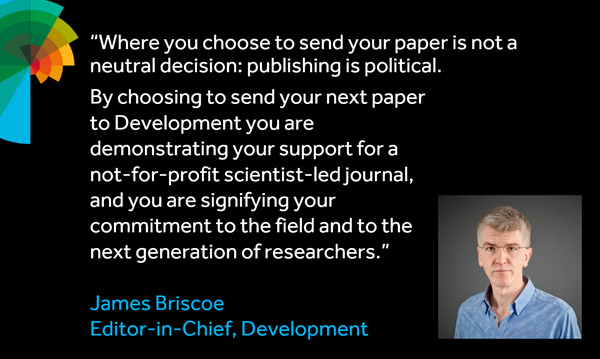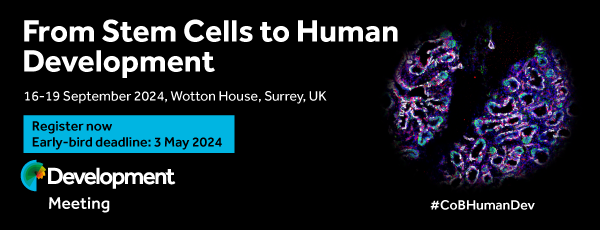Issues
-
Cover image
Cover Image

Cover: A maximum intensity projection of an EomesCreERT;R26mTmG mouse embryo. Eomes-positive cells were labelled at early streak stage by short-term administration of tamoxifen; induced GFP-positive cells were imaged 24 hours later. GFP-positive cells are located in the mesoderm and the definitive endoderm layer. See Research article by Probst et al. (dev193789)
- PDF Icon PDF LinkTable of contents
- PDF Icon PDF LinkIssue info
RESEARCH HIGHLIGHTS
EDITORIAL
OBITUARY
Kathryn Virginia Anderson (1952-2020)
Summary: Developmental geneticist Kathryn Anderson, who defined fundamental mechanisms underlying fly and mouse embryogenesis, is remembered by her former postdoc and friend, Tamara Caspary.
SPOTLIGHTS
What determines organ size during development and regeneration?
Summary: This Spotlight summarizes how cross-disciplinary approaches have advanced our understanding of the autonomous and non-autonomous control of organ growth in multiple species.
What machine learning can do for developmental biology
Summary: This Spotlight reveals the key concepts, advantages and limitations of machine learning, and discusses how these methods are being applied to problems in developmental biology.
REVIEWS
lncRNAs in development and differentiation: from sequence motifs to functional characterization
Summary: This Review discusses advances in the field of lncRNA functions in animal development and physiology, with a particular focus on regulatory RNA sequence motifs.
The complex three-dimensional organization of epithelial tissues
Summary: This Review presents an historical perspective about the study of epithelial organization during development, discussing how and why simplified, but realistic, computational models are required to address key morphogenetic events.
STEM CELLS AND REGENERATION
I-KCKT allows dissection-free RNA profiling of adult Drosophila intestinal progenitor cells
Summary: A dissection-free method to identify proximity-based RNA-protein interactions in an in vivo stem cell population, enabling molecular analysis of these cells at unprecedented speed and resolution.
RESEARCH REPORT
PHOSPHORYLETHANOLAMINE CYTIDYLYLTRANSFERASE 1 modulates flowering in a florigen-independent manner by regulating SVP
Highlighted Article: PECT1 regulates flowering in a florigen-independent manner by activating the expression of SVP in the shoot apical meristem and thus delays flowering
RESEARCH ARTICLES
E2F1 regulates testicular descent and controls spermatogenesis by influencing WNT4 signaling
Highlighted Article:E2f1-null male mice have cryptorchidism and spermatogenic failure. After deletion of Wnt4 in germ cells of E2f1-null mice fertility improves, supporting the hypothesis that E2f1 represses Wnt4 in germ cells.
Androgen action in cell fate and communication during prostate development at single-cell resolution
Summary: Using newly generated mouse genetic tools, we demonstrate the dynamic regulation of mesenchymal androgen signaling as cellular niches controlling prostate early development.
A csf1rb mutation uncouples two waves of microglia development in zebrafish
Summary: The zebrafish b paralog of colony-stimulating factor 1 receptor is an essential positive regulator of HSC-derived myelopoiesis, resulting in macrophage deficiency, including microglia, in adult mutant animals.
Genetic and structural analysis of the in vivo functional redundancy between murine NANOS2 and NANOS3
Summary: NANOS3 protects germ cells against apoptosis in the absence of NANOS2, but it cannot rescue NANOS2 function because of weaker binding ability.
The Clathrin adaptor AP-1 and Stratum act in parallel pathways to control Notch activation in Drosophila sensory organ precursors cells
Summary: The Notch pathway activation relies on the correct localization of the Notch signalling actors. We report that AP-1 and Stratum ensure the basolateral targeting of Notch during asymmetric cell division.
Drosophila Activin signaling promotes muscle growth through InR/TORC1-dependent and -independent processes
Summary: The Activin branch of the TGF-β superfamily regulates Drosophila larval body wall muscle size in all three spatial dimensions through differential control of sarcomeric building block production and assembly.
Spatiotemporal sequence of mesoderm and endoderm lineage segregation during mouse gastrulation
Summary: Cells lineages are specified in the mouse embryo already within the primitive streak in which Mesp1-positive mesoderm and Foxa2-positive endoderm are generated in a spatial and temporal sequence from unbiased progenitors.
Conserved LBL1-ta-siRNA and miR165/166-RLD1/2 modules regulate root development in maize
Summary: Maize LBL1 and its functionally conserved Arabidopsis homologue AtSGS3 regulate root development, possibly by affecting auxin distribution and signalling, in a crosstalk with miR165/166 and their target ROLLED1/2.
Axial skeleton anterior-posterior patterning is regulated through feedback regulation between Meis transcription factors and retinoic acid
Summary: Positive feedback between Meis and retinoic acid regulates axial skeleton patterning in the mouse embryo.
PREPRINT HIGHLIGHTS
Call for papers: Uncovering Developmental Diversity

Development invites you to submit your latest research to our upcoming special issue: Uncovering Developmental Diversity. This issue will be coordinated by our academic Editor Cassandra Extavour (Harvard University, USA) alongside two Guest Editors: Liam Dolan (Gregor Mendel Institute of Molecular Plant Biology, Austria) and Karen Sears (University of California Los Angeles, USA).
Choose Development in 2024

In this Editorial, Development Editor-in-Chief James Briscoe and Executive Editor Katherine Brown explain how you support your community by publishing in Development and how the journal champions serious science, community connections and progressive publishing.
Journal Meeting: From Stem Cells to Human Development

Register now for the 2024 Development Journal Meeting From Stem Cells to Human Development. Early-bird registration deadline: 3 May. Abstract submission deadline: 21 June.
Pluripotency of a founding field: rebranding developmental biology

This collaborative Perspective, the result of a workshop held in 2023, proposes a set of community actions to increase the visibility of the developmental biology field. The authors make recommendations for new funding streams, frameworks for collaborations and mechanisms by which members of the community can promote themselves and their research.
Read & Publish Open Access publishing: what authors say

We have had great feedback from authors who have benefitted from our Read & Publish agreement with their institution and have been able to publish Open Access with us without paying an APC. Read what they had to say.



